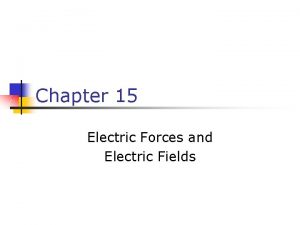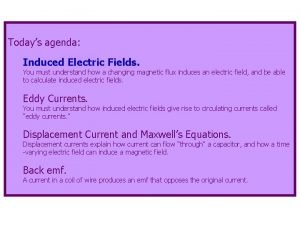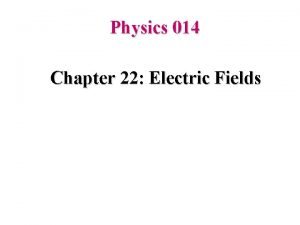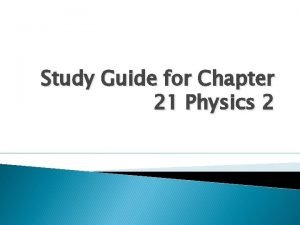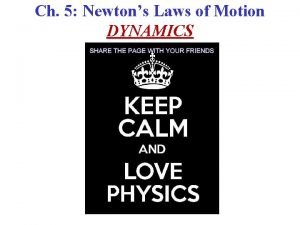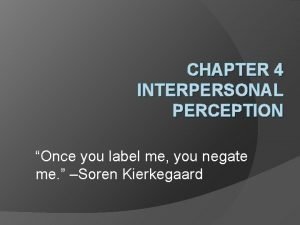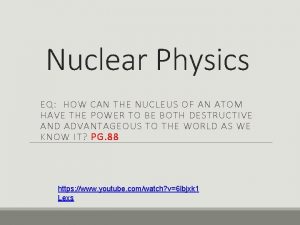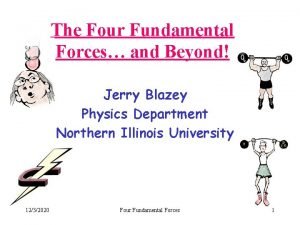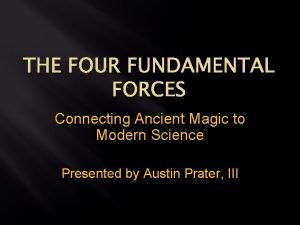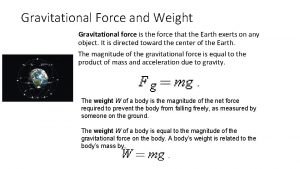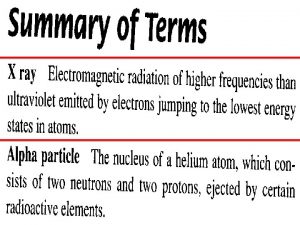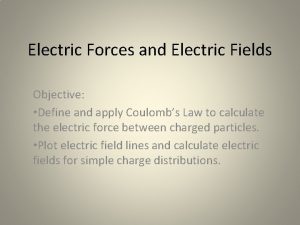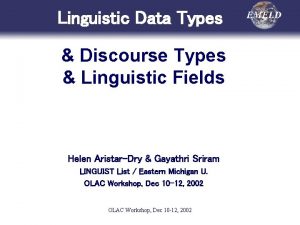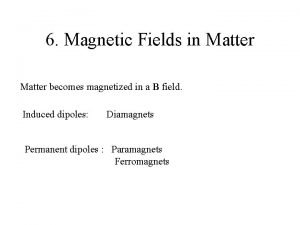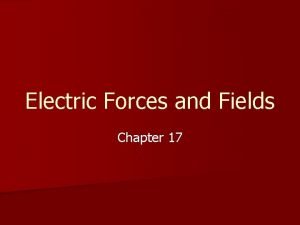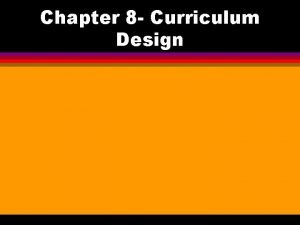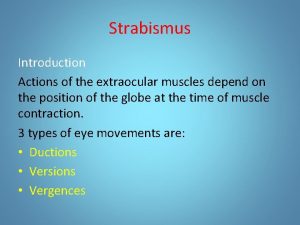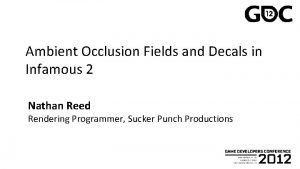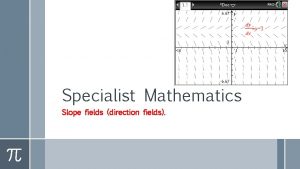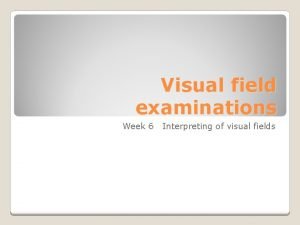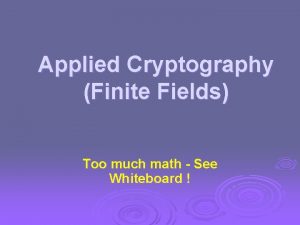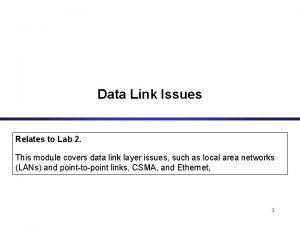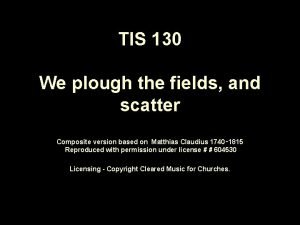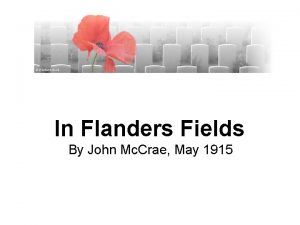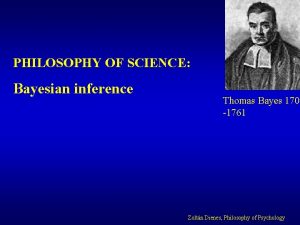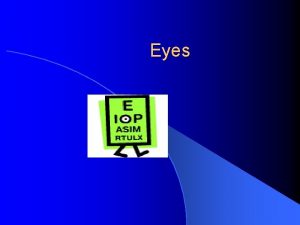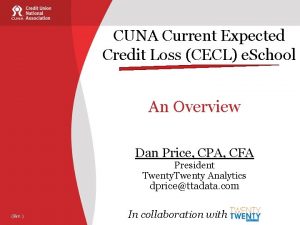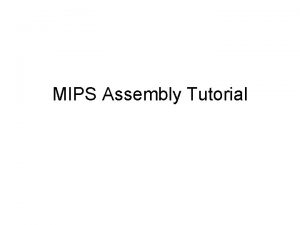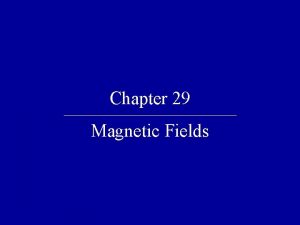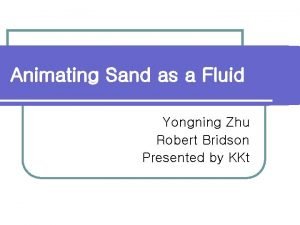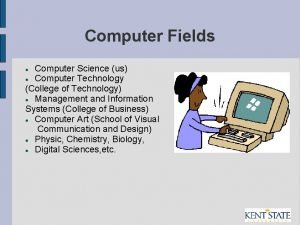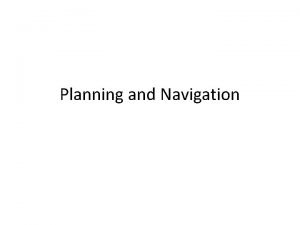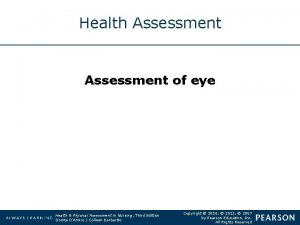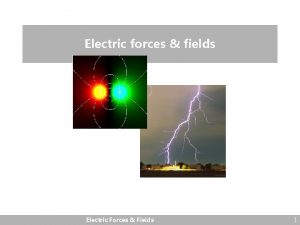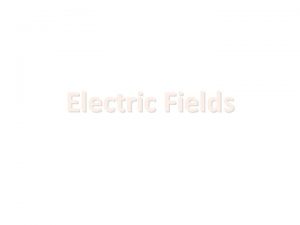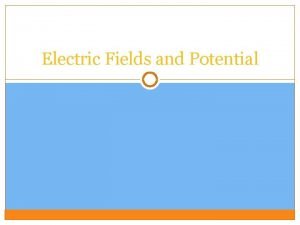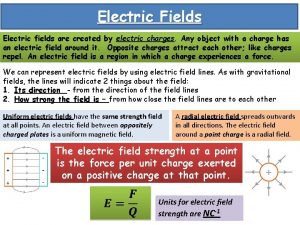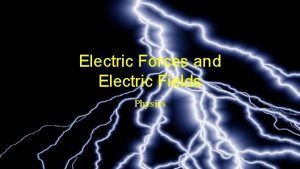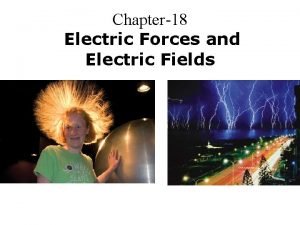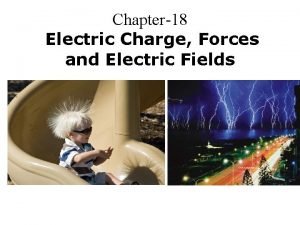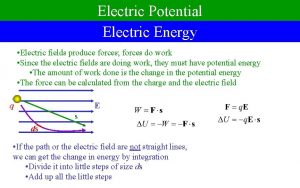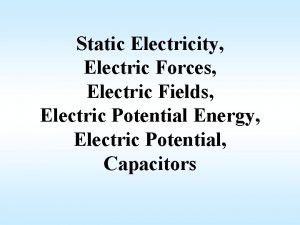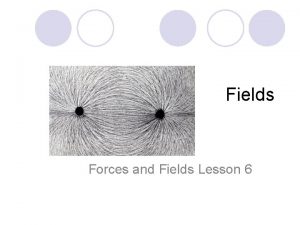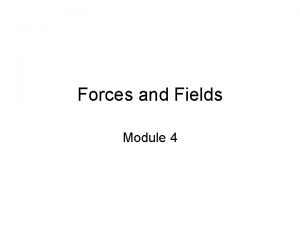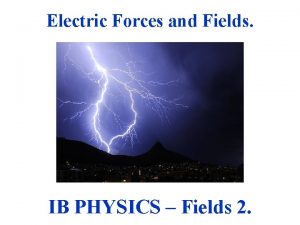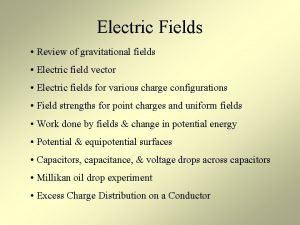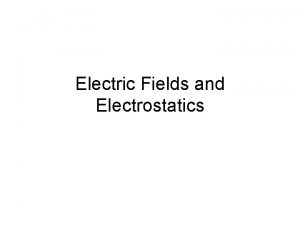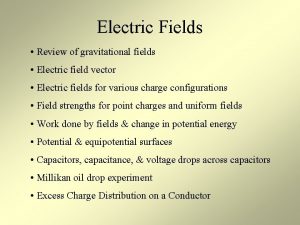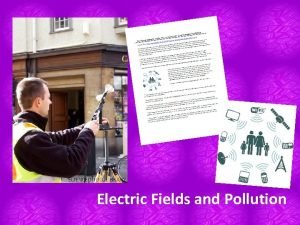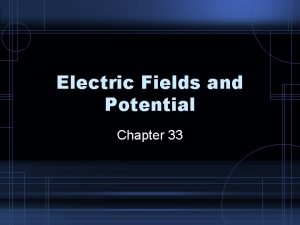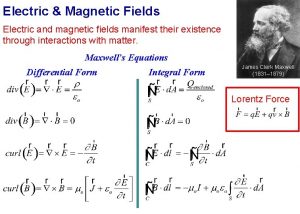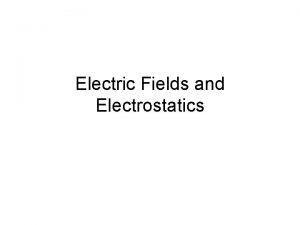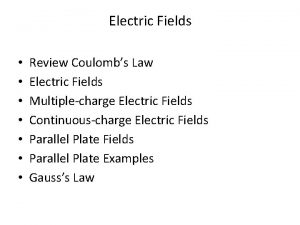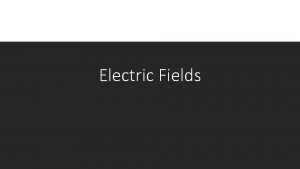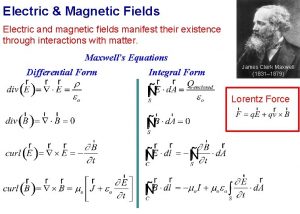5 1 Electric fields Fundamental Forces Watch me















































































- Slides: 79

5. 1 Electric fields

Fundamental Forces Watch me! Physicists have identified four fundamental forces that account for the account all phenomena in the universe. * Force Strength Distance of action Description Strong nuclear Very strong! Very, very Short Holds the nucleus together Weak nuclear Very weak Short Arise during radioactive decay Electromagnetic Very weak Infinite – but decreases Attraction / repulsion of with the square of distance charged particles Gravitational Very, very, very weak Infinite – but decreases Attraction between masses with the square of distance *But why four? Why not just one master force? * Many physicists believe that these four forces are different aspects of ONE fundamental force And that at the beginning of the Universe (up to 10− 43 seconds after the Big Bang), the four fundamental forces were a single fundamental force. – this is the search for the Super. Unified Theory With the exception of gravity, all the forces we studied up to now are due, on a molecular level, to interactions between the electrons of objects – that is, they are caused by the electromagnetic force normal force tension friction force spring force …

“Electricity” – from the Greek word electron ( l ktron) - meaning “amber”. The ancients knew that if you rub an amber rod with a piece of cloth, it attracts small pieces of leaves or dust. Electric Charge No one has ever seen electric charge; it has no weight, color, smell, flavor, length, or width. Electric charge is an intrinsic property of matter. electron has it, proton has it, neutron doesn’t have it – and that’s all • Defined by the effect (force) it produces. • Two types: • Positive charge • Negative charge Electricity has its origin within the atom itself. • Protons have positive charge (+1 e) • Electrons have negative charge (-1 e) • Neutrons have no charge (0) And that’s it! All charges come from protons or electrons! 1706 - 1790, American statesman, philosopher and scientist)

Electricity has origin within the atom itself. 10 -15 m Symb Charge Mass Name ol Electron e 10 -10 m - e Proton p e Neutro n none nm ≈ 2000 x m nucleon 9. 11 x 10 -31 kg 1. 67 x 10 -27 kg electron ratom ≈ 100000 x rnucleus Atom is electrically neutral = has no net charge, since it contains equal numbers of protons and electrons.

Electric forces • charges exert electric forces on other charges – two positive charges repel each other – two negative charges repel each other – a positive and negative charge attract each other + + The repulsive electric force between 2 protons is 1, 000, 000, 000, 000 times stronger than the attractive gravitational force! +

Electrical force is behind all of how atoms are formed … all of chemistry… and, in fact, nearly all common, everyday phenomena other than gravity • charge is measured in Coulombs [C] French physicist Charles A. de Coulomb 1736 - 1806 ▪ Coulomb is defined as the charge transported by a current of one ampere in one second 1 e = 1. 60 10 -19 C the elementary charge 1 C represents the charge of 6. 25 billion (6. 25 x 1018) electrons ! Yet 1 C is the amount of charge passing through a 100 -W light bulb in just over a second. A lot of electrons!

Charge is quantized (i. e. comes in small packets). The smallest amount of the free positive charge is the charge on the proton. qproton = e The smallest amount of the free negative charge is the charge on the electron. qelectron = - e quarks have 1/3, but they come in triplets The net charge of an object is the sum of the individual charges If an atom has 3 protons and 2 electrons, what is its charge? 1 e Can an object have a charge of 1. 5? Explain. No – charges cannot occur in fractions of e • The net charge is the algebraic sum of the individual charges (+ 5 - 3 = 2).

Charged and Uncharged Objects Most objects are electrically neutral – that means they have equal number of positive charges (protons) and negative charges (electrons). Charged objects have unequal numbers of charges. How to make an object charged? • Protons are in the nucleus – they can’t move! • Electrons are outside the nucleus – they can leave their atom, under the right circumstances. Add electrons and make the object negatively charged. Remove electrons and make the object positively charged.

Some materials have atoms that have outer electrons (farthest from nucleus) loosely bound. They can be attracted and can actually move into an outer orbit of another type of atom. This type of charge transfer often occurs when two different materials (different types of atoms) come into contact. • Which object gains the electrons depends on their electron affinity: ▪ electrons can be transferred between objects, but not created or destroyed. ▪ The charges are separated, but the sum is zero. ● Law of Conservation of Charge! Charge is conserved: charge cannot be created or destroyed, but can be transferred from one object to another.

Charge – the conservation of charge PRACTICE: A cat’s fur acts like your hair, when you rub a balloon on it. A balloon has picked up -150 C of charge from Albert. The resulting opposite charges of balloon and Albert cause the balloon to stick. (a) How many electrons have been transferred? (b) What is the charge on Albert? SOLUTION: 1 e- = -1. 60 10 -19 C so… (a) n = (-150 10 -6 C)/ (-1. 60 10 -19 C) = 9. 4 1014 e-. (b) Conservation of charge tells us that q. Albert = +150 C.

Electrical conductors, insulators, semiconductors and superconductors - distinction based on their ability to conduct (transfer between materials) electric charge.

Charge – conductors and nonconductors Materials can be divided into three categories: (1) Conductors - which easily transport electrons without trying to capture or impede them, (2) Nonconductors or insulators - which capture or impede electrons, (3) Semiconductors - which lie between conductors and insulators. Roughly speaking, metals are good conductors, nonmetals are good insulators, and metalloids are good semiconductors.

Conductors A conductor allows electric charge to travel through it easily. to Tap water, human body and metals are generally good conductors. What makes metals conduct? • • Metals have loosely bound electrons (valence electrons – the electrons in the outermost orbits) –In metal, atoms are close to each other and valence electrons from each atom get orbits) confused and forget which atom they belong to. They now belong to the metal as the whole. Positive ions which are tightly bound and in fixed positions can only oscillate around their equilibrium positions, form a positive background. All the homeless electrons are called “free electrons” or “sea of electrons” They wander around, keeping ions from falling apart – metallic bond!! ‘sea of electrons’ in a metal

Insulators are materials that impede the flow of electrons from atom to atom. Insulators have tightly bound electrons – their electrons are not free to move from atom to atom. This makes insulators poor conductors of heat and electricity. Examples: air, pure water, plastic, glass, rubber, wood Electrical breakdown in an insulator Only if a very strong electric field is applied, the breakthrough (molecules become ionized resulting in a flow of freed electrons) could result in destruction of the material. The markings caused by electrical breakdown in this material – look similar to the lightening bolts produced when air undergoes electrical breakdown.

Semiconductors • Materials that can be made to behave sometimes as insulators, sometimes as conductors. ` Eg. Silicon, germanium. In pure crystalline form, are insulators. But if replace even one atom in 10 million with an impurity atom (ie a different type of atom that has a different # of electrons in their outer shell), it becomes an excellent conductor. • Transistors: thin layers of semiconducting materials joined together. Used to control flow of currents, act as switches detect and amplify radio signals, act as digital switches…An integrated circuit contains many transistors

Superconductors • Have zero resistance, infinite conductivity • Not common! Have to cool to very, very low temperatures. • Current passes without losing energy, no heat loss. • Discovered in 1911 in metals near absolute zero (recall this is 0 o. K, -273 o. C) • Discovered in 1987 in non-metallic compound (ceramic) at “high” temperature around 100 K, (-173 o. C) • Under intense research! Many useful applications eg. transmission of power without loss, magnetically-levitated trains… • http: //science. nasa. gov/science-news/science-at-nasa/2003/05 feb_superconductor/ • http: //www. scicymru. info/sciwales/indexphpsectionchoose_scienceuser_type. Pupilpage_id 11696 language. English. htm

Polarization Insulators Conductors Polar Molecules When an object is polarized • One side has + charge • The other side has - charge • The overall charge of the object is zero

Charge polarization in insulators When bringing a charged object near an insulator, electrons are not free to migrate throughout material. Instead, they redistribute within the atoms/molecules themselves: their “centers of charge” move Here, usual atom, with center of electron cloud at positive nucleus Atom is electrically polarized Surfaces of material look like this. (Zero net charge on whole object) When a – charge is brought near the right, electron cloud shifts to the left. Centers of + and – charges no longer coincide.

Compare Charge polarization in insulators and conductors Free electrons are free to move in a conductor Neighboring positive wall induces negative charge. Free electrons move toward the wall. Electrons stay with their atom in an insulator, but atoms become polarized Neighboring positive wall induces negative charge. Molecules are polarized. Most things are in between perfect conductor/ insulator

http: //waiferx. blogspot. com/2013/02/presentationcharges-and-materials. html An example of this is when an insulating object (here, a cat) acquires a charge, due to rubbing or sliding against a different type of insulator. It doesn't matter whether the cat lost electrons (and thus becomes positively charged) or gained electrons (and thus becomes negatively charged) from this rubbing, as in either case the object will still attract neutral insulators (such as these styrofoam packing peanuts).

EXAMPLE - QUESTION Charging by induction Bring a charged object near a conducting surface, electrons will move in conductor even though no physical contact: Due to attraction or repulsion of electrons in conductor to the charged object – since free to move, they will! Once separated from each other with rod still close they’ll remain charged. Charge is conserved, so charges on spheres A and B are equal and opposite. Note, the charged rod never touched them, and retains its original charge.

EXAMPLES :

Example: Van de Graaff The sphere gives the girl a large negative charge. Each strand of hair is trying to: 1) Get away from the charged sphere. 2) Get away from the ground. 3) Get near the ceiling. 4) Get away from the other strands of hair. 5) Get near the wall outlet. Like charges attached to the hair strands repel, causing them to get away from each other.

What is his secret?

Charge – detection using an electroscope • the electroscope is a simple device for observing the presence of electric charge • it consists of a small piece of metal foil (gold if possible) suspended from a rod with a metal ball at its top ++ ++ • If a negatively charged rod is placed near the ball, the electrons move away because of the repulsion. The two sides of the metal foil then separate.

Charge – detection using an electroscope PRACTICE: Consider the three electroscopes shown. Which one has the greatest charge in the leaves? Which one has the least? Can you tell whether the charge is (+) or (-)? Why? SOLUTION: The last one has the most charge, the middle one the least. You cannot tell the sign of the charge since (-)(-) will repel, but so will (+)(+).

Charge – detection using an electroscope during before and after PRACTICE: Explain: A charged wand is brought near an uncharged electroscope without touching it. While the wand is near, the leaves spread apart. SOLUTION: The ball and the leaves are conductors and they are connected to each other. The wand’s charge repels like charges in the ball. The like charges in the ball travel as far as they can to the leaves. The leaves now temporarily hold like charges and thus they repel each other.

You can bend water with charge! The water molecule has a positive end a negative end. charged rod When a negative rod is brought near the stream of water, all the positive ends of the water molecules turn to the right and are attracted to the negative rod. What happens if the rod is charged positively? The same stream of water

Exit Ticket Balloon Example! Explain how a balloon that has been rubbed in hair is able to pick up small pieces of paper or stick to a wall Use the following words in your explanation: electrons protons transfer charged attraction polarization repel force

Balloon Example! • Electrons are transferred from your hair to the balloon, making the balloon be negatively charged (and your hair be positively charged) • When the negatively-charged balloon is held near a neutral object such as a wall, the electrons in the object migrate away from the negatively charged balloon, causing the wall to be polarized • There is a force of attraction between the balloon and the wall.

As we said Like charges repel, and opposite charges attract. This is the fundamental cause of almost ALL electromagnetic behavior. But how much? How Strong is the Electric Force between two charges?

Coulomb’s law Charles-Augustin de Coulomb: Electric force between TWO POINT charges q 1 and q 2 separated by distance r is: k = 8. 99 109 N m 2 C− 2 Coulomb’s law ▪ k is called Coulomb’s constant. There is an alternate form of Coulomb’s law: 0 = 8. 85 10 -12 C 2 N-1 m− 2 Coulomb’s law ▪ 0 is called permittivity of free space 1/[4 0] = 1 / [4 8. 85 10 -12] = 8. 99 109 = k. Either F = kq 1 q 2 / r 2 or F = (1/[4 0])q 1 q 2 / r 2 can be used. It is your choice.

▪ Electric force between TWO POINT charges q 1 and q 2 separated by distance r is a vector

Practice: Coulomb’s law Find the Coulomb force between two electrons located 1. 0 cm apart. SOLUTION: Note r = 1. 0 cm = 0. 010 m. Note q 1 = e = 1. 60 10 -19 C. Note q 2 = e = 1. 60 10 -19 C. From F = kq 1 q 2 / r 2 F = 8. 99 109 (1. 60 10 -19)2 / 0. 0102 = 2. 30 10 -24 N. Since like charges repel the electrons repel.

SHE accumulates a charge q 1 of 2. 0 x 10 -5 C (sliding out of the seat of a car). HE has accumulated a charge q 2 of – 8. 0 x 10 -5 C while waiting in the wind. What is the force between them a) when she opens the door 6. 0 m from him and b) when their separation is reduced by a factor of 0. 5? a) They exert equal forces on each other only in opposite direction (“-“ = attractive force) b) r’ = 0. 5 r Strong force at very small separation spark How many electrons is 2. 0 x 10 -5 C ?

When you comb your hair with a plastic comb, some electrons from your hair can jump onto it making it negatively charged. Your body contains more than 1028 electrons. Suppose that you could borrow all the electrons from a friend’s body and put them into your pocket. The mass of electrons would be about 10 grams (a small sweet). With no electrons your friend would have a huge positive charge. You, on the other hand, would have a huge negative charge in your pocket. If you stood 10 m from your friend the attractive force would be equal to the force that 1023 tons would exert sitting on your shoulders – more 100, 000 times greater than the gravitational force between the earth and the Sun. Luckily only smaller charge imbalances occur, so huge electrical forces like the one described simply do not occur.

Three point charges : q 1= +8. 00 m. C; q 2= -5. 00 m. C and q 3= +5. 00 m. C. (a) Determine the net force (magnitude and direction) exerted on q 1 by the other two charges. (b) If q 1 had a mass of 1. 50 g and it were free to move, what would be its acceleration? 1. 30 m 230 q 1 q 2 230 1. 30 m Force diagram F 3 q 3 q 1 F 2 electric force is very-very strong force, and resulting acceleration can be huge

A positive and negative charge with equal magnitude are connected by a rigid rod, and placed near a large negative charge. In which direction is the net force on the two connected charges? 1) Left 2) Zero 3) Right Positive charge is attracted (force to left) Negative charge is repelled (force to right) Positive charge is closer so force to left is larger. - + -

Coulomb’s law - permittivity ▪ 0 is called permittivity of free space The equation as it stands applies only for charges that are in a vacuum. If the charges are immersed in a different medium (say, air or water) then the value of the permittivity is different Material The table gives a number of permittivity values for different materials. paper rubber water graphite diamond Permittivity /10 -12 C 2 N-1 m-2 34 62 779 106 71

Coulomb’s law – permittivity – practice If the two electrons are embedded in a chunk of quartz, having a permittivity of 12 0, what will the Coulomb force be between them if they are 1. 0 cm apart? SOLUTION: F = (1/[4 ])q 1 q 2 / r 2 = (1/[4 12 8. 85 10 -12]) (1. 60 10 -19)2 / 0. 0102 = 1. 92 10 -25 N.

Coulomb’s law – extended distribution Coulomb’s law works not only for point charges, which have no radii, but for any spherical distribution of charge at any radius. Be very clear that r is the distance between the centers of the charges. Q q r EXAMPLE: A conducting sphere of radius 0. 10 m holds an electric charge of Q = +125 C. A charge q = -5. 0 C is located 0. 30 m from the surface of Q. Find the electric force between the two charges. r = 0. 10 + 0. 30 = 0. 40 m F= k. Qq / r 2 = 8. 99 109 25 10 -6 5. 0 10 -6 / 0. 40 2 = 35 N, toward positive charge

click on the picture to play electrical hokey

Electric Field - definition Let's take a single electric charge, Q, and put it somewhere. If we bring in a second charge, q, it will experience the force. Without q, there is no force. . but we still have the condition that we could have a force. We Due to say that the space around charge contains ELECTRIC FIELD. presence of charge Q Suppose a charge q is located a distance r from a charge Q. Electric field strength E at a point is the force per unit positive test charge placed at that point. E = F / q electric field strength The units are Newtons per Coulomb (N C-1). ▪ Direction of electric field is direction of the force on a (imaginary) positive test charge at point P. (it is a vector!!!!)

The other way around: If you know electric field E at a point where you place a charge q, that charge will experience the force F: F = q E E E q F F q

Electric field of a point charge Q A charged particle Q creates an electric field. Let q be a small charge located a distance r from a charge Q. Find the electric field strength due to Q at a distance r from Q E Field independent of test charge ◊ the same value on the sphere of radius r around ◊ direction – radially outward or inward

Question Say the electric field from an isolated point charge has a certain value at a distance of 1 m. How will the electric field strength compare at a distance of 2 m from the charge? It will be ¼ as much – inverse square law force between two charges carries over to the electric field from a point charge.

We use “Electric Field Lines” to visualize el. field. Convention / agreement Direction indicates direction in which a positive test charge would be pushed – direction of the force!!!.

Electric Field Lines 1. Density gives strength # lines proportional to Q lines never cross! 2. Arrow gives direction Start on +, end on -

Electric monopoles and dipoles If two opposite electric monopoles are near enough to each other their field lines interact as shown here: (-) MONOPOLE (+) MONOPOLE DIPOLE

Solving problems involving electric fields EXAMPLE: Suppose test charges are placed at points A and B in the electric field of the dipole, as shown. Trace their paths when released. SOLUTION: Just remember: Test charges travel C with the field arrows and on the field lines. A PRACTICE: Suppose small negative charges are placed at points C and D in the electric field of the dipole, as shown. Trace their paths when released. SOLUTION: Just remember: (-) charges travel against the field arrows and on the field lines. B D

Mapping fields – Electric field lines Field lines are imaginary ◊ The lines starts on + charges and end on – charges ◊ An arrow is essential to show the direction in which a positive charge would move ◊ Where the field is strong the lines are close together. ◊ The lines never cross. ◊ The lines meet a conducting surface at 90°. monopol dipol uniform electric field El. field at surface of a charged conductor is perpendicular to the conductor’s surface.

Electric field – sketching PRACTICE: We can simplify our drawings of electric fields by using top views and using rays. Which field is that of the… (a) Largest negative charge? D (b) Largest positive charge? A (c) Smallest negative charge? C (d) Smallest positive charge? E SOLUTION: The larger the charge, the more concentrated the field. Lines show the direction a positive test charge will go. Outward is (+) charge, inward (-). A B D C E F

Question? What is the direction of the electric field at point C? 1) Left 2) Right 3) Zero Away from positive charge (right) Towards negative charge (right) y Net E field is to right. C x

Question? What is the direction of the electric field at point A? 1) Up 2) Down 3) Left 4) Right 5) Zero A x

Question? What is the direction of the electric field at point B? 1) Up 2) Down 3) Left 4) Right 5) Zero y B x

Question? What is the direction of the electric field at point A, if the two positive charges have equal magnitude? 1) Up 2) Down 3) Left 4) Right 5) Zero A x

Solving problems involving electric fields EXAMPLE: Two charges of -0. 225 C each are located at opposite corners of a square having a side length of 645 m. Find the electric field vector at E 2 q 1 (a) the center of the square, and (b) one of the unoccupied corners. s E 1 (a) SOLUTION: Start by making a sketch. E 2 = (8. 99 109)(0. 225) / 645 2 = 4860 NC-1 2 E ( ). E 2 = E 12 + E 22 = 2(4860)2 = 47239200 E = 6870 NC-1. 1+ ( ). = (8. 99 109)(0. 225) / 645 2 = 4860 NC-1 E E 1 q 2 s (a)The opposing fields cancel so E = 0. (b) The two fields are at right angles. (b) E 1 E 2 sum points to center of square

Solving problems involving electric fields PRACTICE: Two stationary charges are shown. At which point is the electric field strength the greatest? SOLUTION: Sketch in the field due to each charge at each point. Fields diminish as 1 / r 2. Fields point away from (+) and toward (-). The only place the fields add is point B.

Coulomb’s law – extended distribution Coulomb’s law works not only for point charges, which have no radii, but for any spherical distribution of charge at any radius. Be very clear that r is the distance between the centers of the charges. Q q r EXAMPLE: A conducting sphere of radius 0. 10 m holds an electric charge of Q = +125 C. A charge q = -5. 0 C is located 0. 30 m from the surface of Q. Find the electric force between the two charges. r = 0. 10 + 0. 30 = 0. 40 m F= k. Qq / r 2 = 8. 99 109 25 10 -6 5. 0 10 -6 / 0. 40 2 = 35 N, toward positive charge

Electric field due to charged conducting sphere whether hollow or solid: E = k r E=0 q R E = k E = 0 inside a conductor q at the surface R 2 q r 2

Solving problems involving electric fields PRACTICE: An isolated metal sphere of radius 1. 5 cm has a charge of -15 n. C placed on it. (a) Sketch in the electric field lines outside the sphere. (b) Find the electric field strength at the surface of the sphere. (c) An electron is placed on the outside surface of the sphere and released. What is its initial acceleration? SOLUTION: (a) Field lines point towards (-) charge. (b) The field equation works as if all of the charge is (-) at the center of the spherical distribution. E = k. Q / r 2 (c) The electron feels force F = Eq so that = (8. 99 109)(15 10 -9) / 0. 0152 = 6. 0× 105 NC-1. F = Ee = (6. 0 105)(1. 6 10 -19) = 9. 6 10 -14 N. a = F / m = (9. 6 10 -14) / (9. 11 10 -31) = 1. 1 1017 m s-2.

Solving problems involving electric fields PRACTICE: If the charge on a 25 cm radius metal sphere is +150 C, calculate (a) the electric field strength at the surface. (b) the field strength 25 cm from the surface. (c) the force on a -0. 75 C charge placed 25 cm from the surface. SOLUTION: Use E = k. Q / r 2, and for (c) use E = F / q. (a) E = k. Q / r 2 = (8. 99 109)(150 10 -6) / 0. 25 2 = 2. 2 107 NC-1. (b) E = (8. 99 109)(150 10 -6) / 0. 50 2 = 5. 4 106 NC-1. (c) F = Eq = (5. 4 106)(-0. 75 10 -6) = -4. 0 N. The minus sign means it is an attractive force.

+ + + + ++ - -- - Electric field of a capacitor Uniform electric field (the one that has constant magnitude and direction is generated between two oppositely charged parallel plates. Edge effect is minimazed when the length is long compared to their separation.

Electric field – between parallel plates PRACTICE: Justify the statement “the electric field strength is uniform between two parallel plates. ” SOLUTION: Sketch the electric field lines between two parallel plates. Now demonstrate that the electric field lines have equal density everywhere between the plates.

Electric field – between parallel plates 0. 025 m PRACTICE: The uniform electric field strength inside the parallel plates is 275 N C-1. A +12 C charge having a mass of 0. 25 grams is placed in the field at A and released. (a) What is the electric force acting on the charge? (b) What is the weight of the charge? SOLUTION: (a) F = Eq = (275)(12 10 -6) = 0. 0033 N. E (b) F = mg = (0. 00025)(9. 8) = 0. 0025 N. A (c) What is the acceleration of the charge? SOLUTION: Use Fnet = ma. The electric force is trying to make the charge go up, and the weight is trying to make it go down. Thus Fnet = 0. 0033 - 0. 0025 = 0. 0008 N. Fnet = ma 0. 0008 = 0. 00025 a a = 3. 2 m s-2 ( ).

Potential difference Recall Work: W = F d cos( ) In order to bring two like charges together work must be done. In order to separate two opposite charges, work must be done. The greater charge monkey pushes, the greater work he has to do. The closer he brings it, the harder for him it is. Poor monkey

Although, the definition of the potential at a point is not given, in problems value of potential at points is simply given. As we are going to be interested ONLY in potential differences, definition of potential at a point is not important. For curious people : An electric potential (also called the electric field potential or the electrostatic potential) is the amount of electric potential energy that a unitary point electric charge would have if located at any point in space, and is equal to the work done by an electric field in carrying a unit of positive charge from infinity to that point.

Potential difference Because electric charges experience the electric force, when one charge is moved in the vicinity of another, work W is done. We define the electric potential difference V electric potential difference (∆V) between two points A and B as the amount of work W done per unit charge in moving a point charge from A to B. Q q A units of V are JC-1 which are volts V. potential difference B

Potential difference PRACTICE: A charge of q = +15. 0 C is moved from point A, having a voltage (potential) of 25. 0 V to point B, having a voltage (potential) of 18. 0 V. (a) What is the potential difference undergone by the charge? (b) What is the work done in moving the charge from A to B? SOLUTION: A B q (a) V = VB – VA = 18. 0 – 25. 0 = -7. 0 V. (b) W = q. V = 15. 0 10 -6 -7. 0 = -1. 1 10 -4 J. Many books use V instead of V.

Potential difference – the electronvolt (1 e. V) When speaking of energies of individual charges (like electrons in atoms), rather than large groups of charges (like currents through wire), Joules are too large and awkward. We define the electronvolt e. V as the work done when an elementary charge e is moved through a potential difference V. From W = q. V we see that 1 e. V = (1. 60 10 -19 C)(1 V) = 1. 60 10 -19 J. 1 e. V = 1. 60 10 -19 J electronvolt conversion electronvolts are almost exclusively used in atomic and nuclear physics.

Potential difference – the electronvolt (1 e. V) PRACTICE: An electron is moved from Point A, having a voltage (potential) of 25. 0 V, to Point B, having a voltage (potential) of 18. 0 V. (a) What is the work done (in e. V and in J) on the electron by the external force during the displacement? A B q SOLUTION: W = q(VB – VA). W = -e(18. 0 V – 25. 0 V) = 7. 0 e. V. 7. 0 e. V (1. 60 10 -19 J / e. V) = 1. 12 10 -18 J. (b) If the electron is released from Point B, what is its speed when it reaches Point A? A SOLUTION: EK + EP = 0 with EP = – 1. 12 10 -18. EK = – EP (1/2)mv 2 – (1/2)mu 2 = –(– 1. 12 10 -18) (1/2)(9. 11 10 -31)v 2 = 1. 12 10 -18 v = 1. 57 106 ms-1. q B Since the electron is more attracted to A than B, we have stored this energy as potential energy.

Potential difference – path independence EXAMPLE: A charge of q = +15. 0 C is moved from point A, having a voltage (potential) of 25. 0 V to point B, having a voltage (potential) of 18. 0 V, in three different ways. What is the work done in each case? SOLUTION: A B The work is independent of the path because the electric force is a conservative force. W = q. V = 15. 0 10 -6 -7. 0 = -1. 1 10 -4 J. Same for all. Gravitational force is also a conservative force. You remember that work done by gravitational force will be the same (converted into KE) if we throw a stone from certain height with the same speed in any direction.

Potential difference – between parallel plates PRACTICE: Two parallel plates with plate separation d are charged up to a potential difference of V simply by connecting a battery (shown) to them. The electric field between the plates is E. A positive charge q is moved from A to B. is moved A (a) How much work is done in moving q through the distance d? (b) Find the potential difference V across the plates. SOLUTION: W = Fd cos , F = Eq, and W = q. V. (a) W = Fd cos 0° = (Eq)d. (b) q. V = Eqd V = Ed. d E B

Potential difference – between parallel plates PRACTICE: Two parallel plates with plate separation 2. 0 cm are charged up to the potential difference shown. Which one of the following shows the correct direction and strength of the resulting electric field? SOLUTION: Since the greater positive is plate Y, the electric field lines point from Y X. From V = Ed we see that E = V / d = (100 – 50) / 2 = 25 V cm-1.

Identifying sign and nature of charge carriers in a metal In 1916 conclusive proof that the charge carriers in a metal are electrons (-) was obtained by Tolman and Stewart. The metal atoms in a solid are bound together by the metallic bond. When a metal solidifies from a liquid, its atoms form a regular lattice arrangement. The shape of the lattice varies from metal to metal but the common feature of metals is that as the bonding happens, electrons are donated from the outer shells of the atoms to a common sea of electrons that occupies the entire volume of the metal. The positive ions sit in fixed positions on the lattice. There are ions at each lattice site because each atom has now lost an electron. Of course, at all temperatures above absolute zero they vibrate in these positions.

Drift velocity In a metal, free electrons move very rapidly, but collide constantly with the atoms in the crystalline lattice structure of the metal. Note that through any cross-section of the conductor, the net current is zero. At macroscopic level current is zero. If we place that same portion of conductor under the influence of a potential difference (electric field is established), there is a NET movement toward the lower potential: V net current is NOT zero in this case. The electrons still have a high velocity, but this time the net migration is in the direction of the lower potential. The speed of this net migration is called the drift velocity.

Drift speed • When a battery is connected across the ends of a metal wire, an electric field is produced in the wire. • All free electrons in the circuit start moving at the same time. • Free electrons are accelerated reaching enormous speeds of about 106 ms-1. They collide with positive ions of crystal lattice generating heat that causes the temperature of the metal to increase. • After that, they are again accelerated because of the electric field, until the next collision occurs. • Due to the collisions with positive ions of crystal lattice, hence changing direction, it is estimated that the drift velocity is only a small fraction of a metre each second (about 0. 1 mm/s). example: it takes ~ 3 hour for an electron to travel through 1 m in an electric circuit of a car. it’s not even a snail’s pace!!!!!

Drift speed ▪ Imagine a cylindrical conductor that is carrying an electric current I. ▪ The cross-sectional area of the conductor is A ▪ It contains charge carriers each with charge q. ▪ n is charge carriers density ▪ We assume that each carrier has a speed v v t A Q v Through any time interval t, only the charges Q between the two black cross-sections will provide the current I. The volume containing the charge Q is V = Av t. Thus Q = n. Vq = n. Av tq. Finally, I = Q / t = n. Avq. I = n. Avq current vs. drift velocity

Drift speed I = n. Avq current vs. drift velocity PRACTICE: Suppose the current in a 2. 5 mm diameter copper wire is 1. 5 A and the number density of the free electrons is 5. 0 1026 m-3. Find the drift velocity. SOLUTION: Use I = n. Avq, where A = d 2/ 4 = (2. 5 10 -3) 2/ 4 = 4. 91 10 -6 m 2. v = I / [n. Aq] = 1. 5 / [5. 0 1026 4. 91 10 -6 1. 6 10 -19 ] = 0. 0038 ms-1.
 Chapter 16: electric forces and fields answers
Chapter 16: electric forces and fields answers Electric forces and fields concept review
Electric forces and fields concept review Electric charges and electric forces lesson outline
Electric charges and electric forces lesson outline Red fields
Red fields Electric fields quiz
Electric fields quiz Field
Field Electric field for a disk
Electric field for a disk Chapter 33 electric fields and potential
Chapter 33 electric fields and potential Physics 2 study guide
Physics 2 study guide Electric fields
Electric fields Electric currents and magnetic fields
Electric currents and magnetic fields Electric fields
Electric fields Electric currents and magnetic fields
Electric currents and magnetic fields Learning: module 26: magnetic forces and fields
Learning: module 26: magnetic forces and fields Basic laws of dynamics
Basic laws of dynamics Fundamental forces in interpersonal perception
Fundamental forces in interpersonal perception Uses of radioactive isotopes in agriculture
Uses of radioactive isotopes in agriculture Four fundamental forces
Four fundamental forces Four fundamental forces
Four fundamental forces Weight and force
Weight and force Electric field electric potential
Electric field electric potential Units of charge
Units of charge Electric potential equation
Electric potential equation A suitable electric pump in an electric circuit is a
A suitable electric pump in an electric circuit is a Chapter 21 electric charge and electric field
Chapter 21 electric charge and electric field Electric potential due to a dipole
Electric potential due to a dipole Chapter 21 electric charge and electric field
Chapter 21 electric charge and electric field Electric potential energy definition
Electric potential energy definition Chapter 21 electric charge and electric field
Chapter 21 electric charge and electric field Electric forces within an atomic nucleus tend to
Electric forces within an atomic nucleus tend to Define electric forces
Define electric forces Unbalanced force
Unbalanced force δ+
δ+ Is deposition constructive or destructive
Is deposition constructive or destructive Find the resultant of two like parallel forces
Find the resultant of two like parallel forces Inter vs intramolecular forces
Inter vs intramolecular forces The forces shown above are
The forces shown above are Contact vs noncontact forces
Contact vs noncontact forces Intermolecular forces vs intramolecular forces
Intermolecular forces vs intramolecular forces Linguistic fields
Linguistic fields Magnetic fields in matter
Magnetic fields in matter What are the allied fields of physical education
What are the allied fields of physical education 5 major fields of psychology
5 major fields of psychology Storm fields
Storm fields Rodan and fields tax write offs
Rodan and fields tax write offs Experience centered design
Experience centered design 6 cardinal fields of gaze
6 cardinal fields of gaze Natural language processing fields
Natural language processing fields Ao fields
Ao fields How to draw slope fields
How to draw slope fields Interpreting visual fields
Interpreting visual fields Finite fields in cryptography
Finite fields in cryptography 10 fields
10 fields Ethernet ii frame fields
Ethernet ii frame fields Jd sports fields
Jd sports fields Kotebe metropolitan university computer science
Kotebe metropolitan university computer science Fields virology
Fields virology We plow the fields and scatter
We plow the fields and scatter Empower custom fields validation
Empower custom fields validation 2829 elysian fields avenue
2829 elysian fields avenue Word shades fields ____ on the screen
Word shades fields ____ on the screen In flanders fields summary
In flanders fields summary Eran fields
Eran fields Sketching slope fields
Sketching slope fields Thomas morphic fields
Thomas morphic fields L
L Cecl data fields
Cecl data fields I type mips
I type mips Magnetic fields quick
Magnetic fields quick A gown made of the finest wool
A gown made of the finest wool Rsform conditional fields
Rsform conditional fields Xxxx and
Xxxx and Into the fields internship
Into the fields internship Wo yongning
Wo yongning Cambodian genocide
Cambodian genocide How many fields in computer science
How many fields in computer science Potential fields
Potential fields Corneal light reflex
Corneal light reflex Finland fields
Finland fields Percuss anterior chest
Percuss anterior chest




